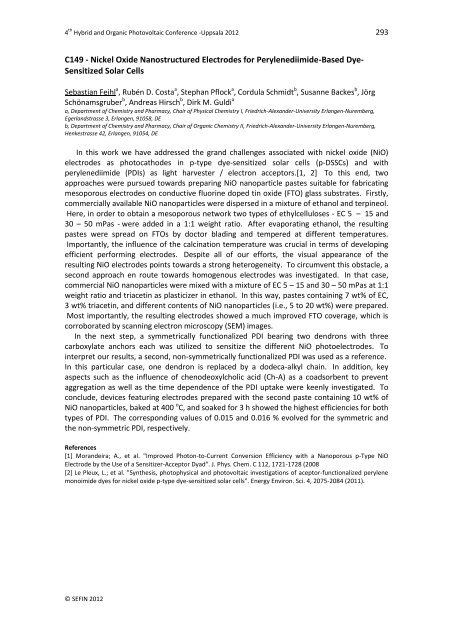HOPV12 - Blogs
HOPV12 - Blogs
HOPV12 - Blogs
Create successful ePaper yourself
Turn your PDF publications into a flip-book with our unique Google optimized e-Paper software.
4 th Hybrid and Organic Photovoltaic Conference -Uppsala 2012 293<br />
C149 - Nickel Oxide Nanostructured Electrodes for Perylenediimide-Based Dye-<br />
Sensitized Solar Cells<br />
Sebastian Feihl a , Rubén D. Costa a , Stephan Pflock a , Cordula Schmidt b , Susanne Backes b , Jörg<br />
Schönamsgruber b , Andreas Hirsch b , Dirk M. Guldi a<br />
a, Department of Chemistry and Pharmacy, Chair of Physical Chemistry I, Friedrich-Alexander-University Erlangen-Nuremberg,<br />
Egerlandstrasse 3, Erlangen, 91058, DE<br />
b, Department of Chemistry and Pharmacy, Chair of Organic Chemistry II, Friedrich-Alexander-University Erlangen-Nuremberg,<br />
Henkestrasse 42, Erlangen, 91054, DE<br />
In this work we have addressed the grand challenges associated with nickel oxide (NiO)<br />
electrodes as photocathodes in p-type dye-sensitized solar cells (p-DSSCs) and with<br />
perylenediimide (PDIs) as light harvester / electron acceptors.[1, 2] To this end, two<br />
approaches were pursued towards preparing NiO nanoparticle pastes suitable for fabricating<br />
mesoporous electrodes on conductive fluorine doped tin oxide (FTO) glass substrates. Firstly,<br />
commercially available NiO nanoparticles were dispersed in a mixture of ethanol and terpineol.<br />
Here, in order to obtain a mesoporous network two types of ethylcelluloses - EC 5 – 15 and<br />
30 – 50 mPas - were added in a 1:1 weight ratio. After evaporating ethanol, the resulting<br />
pastes were spread on FTOs by doctor blading and tempered at different temperatures.<br />
Importantly, the influence of the calcination temperature was crucial in terms of developing<br />
efficient performing electrodes. Despite all of our efforts, the visual appearance of the<br />
resulting NiO electrodes points towards a strong heterogeneity. To circumvent this obstacle, a<br />
second approach en route towards homogenous electrodes was investigated. In that case,<br />
commercial NiO nanoparticles were mixed with a mixture of EC 5 – 15 and 30 – 50 mPas at 1:1<br />
weight ratio and triacetin as plasticizer in ethanol. In this way, pastes containing 7 wt% of EC,<br />
3 wt% triacetin, and different contents of NiO nanoparticles (i.e., 5 to 20 wt%) were prepared.<br />
Most importantly, the resulting electrodes showed a much improved FTO coverage, which is<br />
corroborated by scanning electron microscopy (SEM) images.<br />
In the next step, a symmetrically functionalized PDI bearing two dendrons with three<br />
carboxylate anchors each was utilized to sensitize the different NiO photoelectrodes. To<br />
interpret our results, a second, non-symmetrically functionalized PDI was used as a reference.<br />
In this particular case, one dendron is replaced by a dodeca-alkyl chain. In addition, key<br />
aspects such as the influence of chenodeoxylcholic acid (Ch-A) as a coadsorbent to prevent<br />
aggregation as well as the time dependence of the PDI uptake were keenly investigated. To<br />
conclude, devices featuring electrodes prepared with the second paste containing 10 wt% of<br />
NiO nanoparticles, baked at 400 o C, and soaked for 3 h showed the highest efficiencies for both<br />
types of PDI. The corresponding values of 0.015 and 0.016 % evolved for the symmetric and<br />
the non-symmetric PDI, respectively.<br />
References<br />
[1] Morandeira; A., et al. "Improved Photon-to-Current Conversion Efficiency with a Nanoporous p-Type NiO<br />
Electrode by the Use of a Sensitizer-Acceptor Dyad". J. Phys. Chem. C 112, 1721-1728 (2008<br />
[2] Le Pleux, L.; et al. "Synthesis, photophysical and photovoltaic investigations of aceptor-functionalized perylene<br />
monoimide dyes for nickel oxide p-type dye-sensitized solar cells". Energy Environ. Sci. 4, 2075-2084 (2011).<br />
© SEFIN 2012


